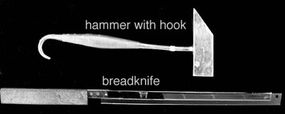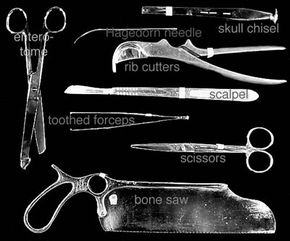Tools of the Trade

The tools used to perform autopsies have changed very little in the past 100 years. The only real major advance in tools is the addition of some electrical saws. But even those are still not used as often as the good old-fashioned hand tools.
- Bone saw: used to cut through bone or skull
- Bread knife: used to shave slices off of organs for examination
- Enterotome: special scissors used to open the intestines
- Hagedorn needle: a heavy needle used to sew up the body after examination
- Hammer with hook: used to pull skull cap off of skull
- Rib cutter: special shears used to cut through the ribs
- Scalpel: like a surgeon's scalpel but with largest blade possible for making long deep cuts or scraping away tissue
- Scissors: used for opening hollow organs and cutting vessels
- Skull chisel: used for helping to carefully pry the skull cap off
- Stryker saw: the electric saw used to cut through the skull to remove the brain
- Toothed forceps: used to pick up heavy organs
"We don't always use nice, delicate, surgical tools," Kiesel says. "If you put the word medical or autopsy on something, the price triples, so ... I can go to a restaurant supply house and get some good knives that cost me just a fraction of what it would cost to buy them elsewhere."
Advertisement
Autopsy tool shopping doesn't stop at the restaurant supply house. The medical examiner may also visit a hardware store for supplies. "Things like pruning shears tend to work better than surgical bone cutters for cutting through ribs. You know, a scalpel blade's only got an inch, inch and a half worth of cutting surface, whereas you can get a good, long knife that's got a 6-to-8-inch blade on it so you can cut more and faster," Kiesel says. "We're not doing very delicate surgical procedures where we have to worry about if we nick the wrong thing somebody's going to bleed. So, our tools aren't quite that delicate, but we can still do some reasonably sophisticated things ... It's not like doing delicate microsurgery."
While this may seem gruesome, Kiesel says medical examiners are forced to work on a budget, and saving money on tools frees up funds for use on other investigative resources.
In the next section, we will learn how medical examiners unravel the mystery of time of death.
